Text
that's a nice delta you've got there. would be a shame if someone rotated it to form a vector differential operator
7 notes
·
View notes
Text
looking at someone's tumblr icon and excitedly going "look that's them that's my little guy" like someone seeing their favourite character and it's the octahedron default icon
#math#polyhedra#shapes#it's a shame many of them are bots#i love polyhedron appearances on this site
0 notes
Text
the relation of coxeter groups and systems to the symmetries of regular polytopes is really fascinating to me. the fact that you can start with these equivalence classes of strings of letters and end up with descriptions of polytope symmetries with higher dimensions than we'll ever be able to visualise makes sense when you know the context, but it also says something about how important representations and abstractions are to math and how fundamentally related a lot of things are within it. also, coxeter diagrams are pretty neat.
0 notes
Text
the only number is 0 and the only math is +1 and this system DOES work for EVERYthing and if i’m wrong i will PERSONALLY eat my hat
2K notes
·
View notes
Text
i think big number-naming competitions should be more widespread. like spelling bees, except if you had to make up the words by continuously inventing more compact representations of larger words based on repeating individual rules applied to the previous word created by your opponent, all within a time limit. the prize for first place would be getting to see the audience go oh no. Oh No. as they try to comprehend your number
#the only problem i can anticipate is if competitors started to create uncountable numbers#this is a joke (mostly)#and a callback to the mit big number duel#math#mathematics#googology
1 note
·
View note
Text
a lot of geometry-interested people know about truncation (and for good reason, seeing as it gives us a lot of the Archimedean solids from the Platonic solids), but I think more of us should talk about geometrical chamfering, also known as edge-truncation. this operation is essentially truncating the edges of a polyhedron instead of the vertices! chamfering a cube results in the chamfered cube, which is a near-miss Johnson solid. you can also think of chamfering as adding hexagonal faces where each edge of a shape originally was. repeatedly chamfering a shape gives you a sequence of Goldberg polyhedra, which is really neat.



above, from left to right: the chamfered icosahedron, chamfered dodecahedron, and chamfered cube.
image sources:
T. Piesk, Polyhedron chamfered 20 edeq max, 11 February 2018, https://en.wikipedia.org/wiki/Chamfer_(geometry), CC BY 4.0.
T. Piesk, Polyhedron chamfered 12 edeq max, 11 February 2018, https://en.wikipedia.org/wiki/Chamfer_(geometry), CC BY 4.0.
T. Piesk, Polyhedron chamfered 6 edeq max.png, 11 February 2018, https://en.wikipedia.org/wiki/Chamfer_(geometry), CC BY 4.0.
0 notes
Text

[trying to sound casual] how much would the rent be for living inside of it
(a three-dimensional cross-section of the small diretrosnub disnub decahecatonicosadishexacosichoron (sadros daskydox, for short), obtained from a subpage on jonathan bowers' polychoron website.)
#polyhedra#math#geometry#shapes#polychora#sadros daskydox#<- not sure how many people have used that tag before
0 notes
Text
fermions are subatomic particles that can be thought of as "matter particles" (as opposed to bosons, which can be thought of as "force particles"), because some of them make up all atoms. the fermions listed here that are not quarks (electron, muon, tau, and their neutrino counterparts) are known collectively as leptons. all fermions have half-integer quantum spin numbers, which means that they follow the Pauli exclusion principle (two of them cannot occupy the same quantum state in a system governed by quantum mechanics).
(i couldn't fit all the particles in the standard model in one poll so i had to resort to only including the fermions :()
this is just for fun! feel free to reblog with the reasoning behind your fermion of choice.
0 notes
Text

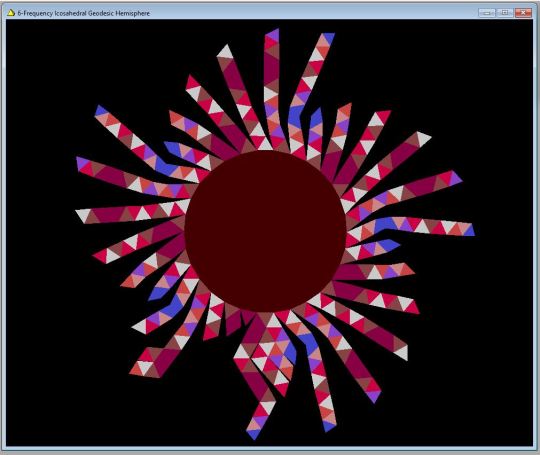
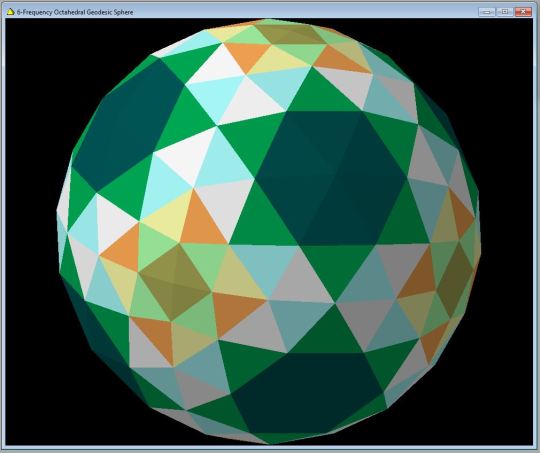
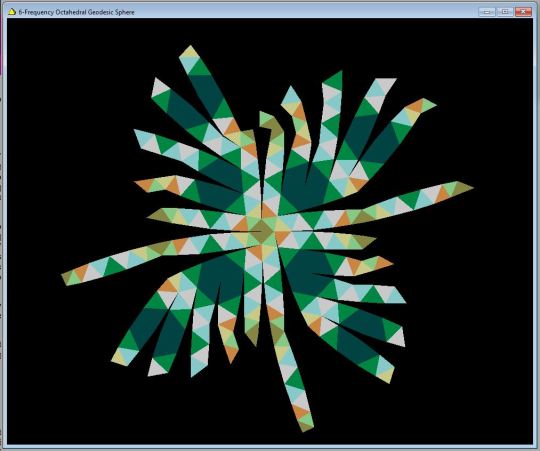

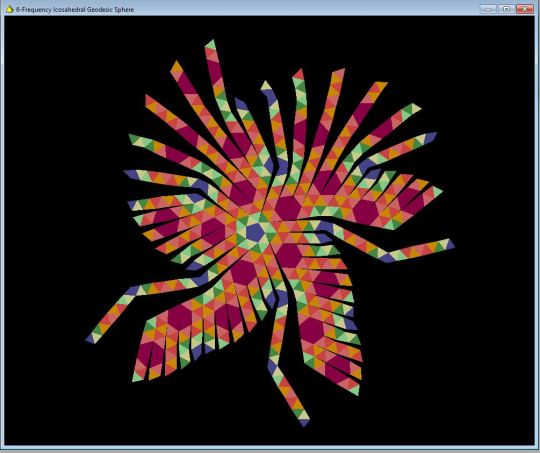
some assorted angels i thought were very beautiful.
the program is poly 1.12! i highly recomend for polyhedra viewing. its super cool and has so many!!! you can choose the color of the faces as well. you can get it for free at peda.com (pedagoguery software).
incase the text is too small the shapes in order are:
6-frequency icosahedral geodesic hemishere
6-frequency octahedral geodesic sphere
6-frequency icosahedral geodesic sphere
also yay my first post on this blog!!! :]
71 notes
·
View notes
Text

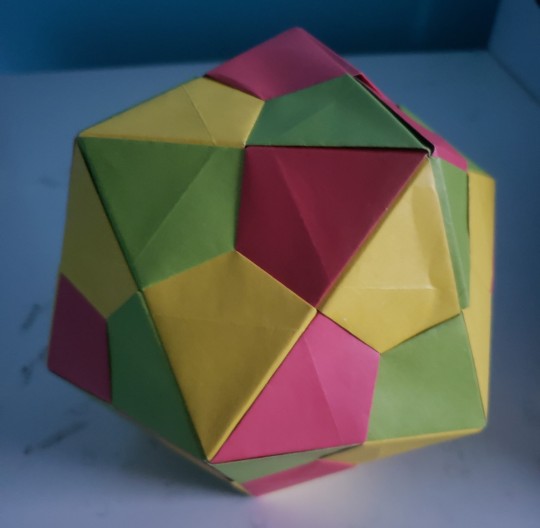
icosahedron made of 30 triangle edge modules i made yesterday. the colours didn't work out on some faces, so i'll have to try it again sometime.
4 notes
·
View notes
Text
Great stellated dodecahedron

For that Kepler-Poinsot-Polyhedron I started to draw an icosahedron and continued to add triangular pyramids as "hats" on top of each of the 20 triangular icosahedron faces.
- - -- ---
This is the Small Stellated Dodecahedron I drew a while back:

- - -- ---
How are the Dodecahedron, Icosahedron, Small and Great Stellated Dodecahedron related?

(Source)
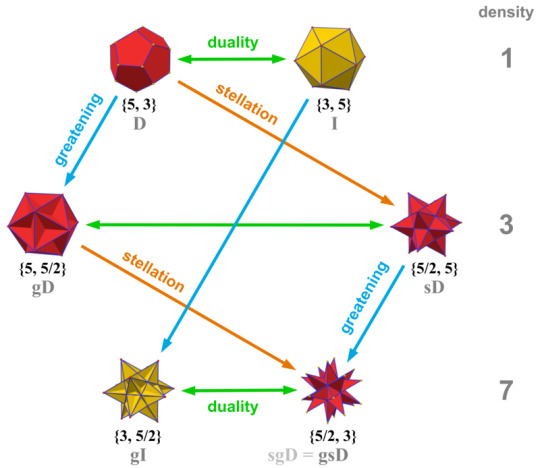
Truncation of the Small Stellated Dodecahedron:

Truncation of the Great Stellated Dodecahedron:
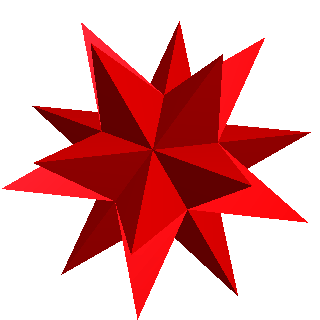
126 notes
·
View notes
Text
group theory: abstracting symmetries
ring theory: abstracting arithmetic
graph theory: abstracting relationships
category theory: abstracting composed functions
math theory: abstracting abstractions
#i don't know if there's already a field of math called “math theory”#for the joke i'm assuming there isn't#but let me know if there is#math#numbers
2 notes
·
View notes
Text
i love when researchers do stuff like this
#physics#rheology#this was a really interesting read#i recommend it if you're interested in fluid mechanics or physics in general
0 notes
Text

ellipse and hyperbola tomfoolery in desmos
37 notes
·
View notes
Text
here's a fun concept:
imagine a function f(x) where f(x) = x↑[x↑[x↑[x...]x]x]x. where the number of nested ↑[x↑x] structures (number of up arrows = x↑x) equals x.
f(1) = 1↑[1↑1]1 (1↑...↑1, number of up arrows = 1↑1) = 1↑1 = 1
f(2) = 2↑[2↑[2↑2]2]2 = 2↑[2↑[4]2]2 = 2↑[2↑↑↑↑2]2 = 2↑...↑2, number of up arrows = 2↑↑↑↑2)
etc.
2 notes
·
View notes

